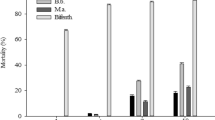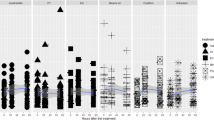Abstract
LITTLE is known of the susceptibility to synthetic organic substances of the summer stages of the fruit tree red spider mite, Metatetranychus ulmi (Koch) (syn. Paratetranychus pilosus C. and F.), although recent work on this pest1, and on the related mite Tetranychus telarius L.2–5, has suggested that azobenzene is appreciably toxic. Consequently, we have recently examined in the laboratory, using M. ulmi as a test-organism, a series of compounds related to azobenzene, with the view of investigating the relation between toxicity and chemical structure.
This is a preview of subscription content, access via your institution
Access options
Subscribe to this journal
Receive 51 print issues and online access
$199.00 per year
only $3.90 per issue
Buy this article
- Purchase on Springer Link
- Instant access to full article PDF
Prices may be subject to local taxes which are calculated during checkout
Similar content being viewed by others
References
Hey, G. L., The Grower, 26, 298 (1946).
Blauvelt, W. E., N.Y. St. Flower Gr. Bull., 2, 6 (1945).
Haring, R. C., J. Econ. Ent., 39, 78 (1946).
Read, W. H., Rep. Exp. Res. Sta., Cheshunt, 59 (1946).
Speyer, E. R., and Parr, W. J., Rep. Exp. Res. Sta., Cheshunt, 46 (1946).
Author information
Authors and Affiliations
Rights and permissions
About this article
Cite this article
EATON, J., DAVIES, R. Toxicity of Azo-Compounds and Other Substances to the Fruit Tree Red Spider Mite. Nature 161, 644–645 (1948). https://doi.org/10.1038/161644a0
Issue Date:
DOI: https://doi.org/10.1038/161644a0
This article is cited by
-
A New Acaricide, 2,4,5,4′-Tetrachlorodiphenylsulphone
Nature (1955)
-
Het onderzoek van acariciden en spintoviciden in het laboratorium
Tijdschrift Over Plantenziekten (1955)
Comments
By submitting a comment you agree to abide by our Terms and Community Guidelines. If you find something abusive or that does not comply with our terms or guidelines please flag it as inappropriate.



